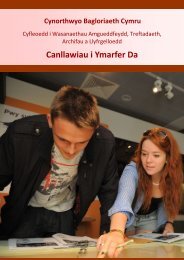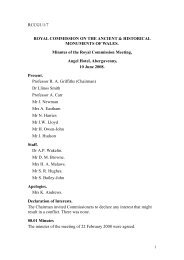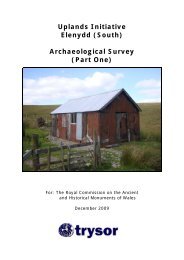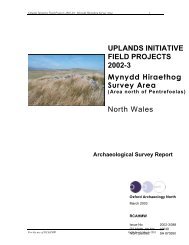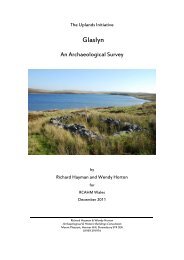Plynlimon (central) - Royal Commission on the Ancient and ...
Plynlimon (central) - Royal Commission on the Ancient and ...
Plynlimon (central) - Royal Commission on the Ancient and ...
Create successful ePaper yourself
Turn your PDF publications into a flip-book with our unique Google optimized e-Paper software.
Upl<strong>and</strong>s Initiative – Nant y Moch & Pumlim<strong>on</strong> Fawr / <str<strong>on</strong>g>Plynlim<strong>on</strong></str<strong>on</strong>g> 2004Wales‘. The sale of tickets for <strong>the</strong> lottery was opened to <strong>the</strong> general public in October 1698; over£25,000 was subscribed <strong>on</strong> <strong>the</strong> first day. In five m<strong>on</strong>ths enough tickets had been sold to enable <strong>the</strong>prize draw to be held. Those who held <strong>the</strong> first 700 tickets to be drawn were also to share in <strong>the</strong>management of <strong>the</strong> company.One of <strong>the</strong> men behind <strong>the</strong> scheme was William Waller, a former employee of <strong>the</strong> Mines <str<strong>on</strong>g>Royal</str<strong>on</strong>g>Society in Westmorl<strong>and</strong>, where he had been dismissed for some misdemeanour. He <strong>the</strong>n made apractice of invading <strong>the</strong> rights of <strong>the</strong> Society until he was forced to leave <strong>the</strong> area. He settled inCardiganshire <strong>and</strong> attached himself to Sir Carbery Pryse, whom he persuaded to defy <strong>the</strong> Mines<str<strong>on</strong>g>Royal</str<strong>on</strong>g> Society. It was Waller, too, who persuaded Mackworth to take over <strong>the</strong> mines. Thecompany's prospectus, written by Waller, c<strong>on</strong>tained many exaggerati<strong>on</strong>s, such as <strong>the</strong> statement thatEsgair-hir had ‗eight large veins of silver, lead <strong>and</strong> copper … which can't be parallelled in <strong>the</strong>whole of <strong>the</strong> Christian World‘. He called <strong>the</strong> mine ‗<strong>the</strong> Welsh Potosi‘ to emphasize its similarity to<strong>the</strong> great silver mines of Bolivia. Thous<strong>and</strong>s of pamphlets describing <strong>the</strong> mine <strong>and</strong> its prospects inglowing terms were distributed throughout Britain in order to attract investors.In practice, <strong>the</strong> much-publicized treasures of <strong>the</strong> Welsh Potosi proved difficult to unearth <strong>and</strong> it wasnot l<strong>on</strong>g before shareholders became restive. Statements, most of <strong>the</strong>m misleading <strong>and</strong> prepared byWaller, were sent out in an attempt to restore c<strong>on</strong>fidence. The main difficulty was ridding <strong>the</strong> mineof water <strong>and</strong> Waller ‗was not skilled in engines‘ which could do this work. Eventually committeesof inspecti<strong>on</strong> visited <strong>the</strong> mine <strong>and</strong> found much to c<strong>on</strong>demn in Waller's management. He wasdismissed <strong>and</strong> forced to leave his house at Ynys-hir. He <strong>the</strong>n went to L<strong>on</strong>d<strong>on</strong> where he c<strong>on</strong>ducted acampaign of vilificati<strong>on</strong> against <strong>the</strong> Company of Mine Adventurers.For <strong>the</strong> first ten years of working <strong>the</strong> mines of Cardiganshire, <strong>the</strong> company had little to show.Although it leased twenty-eight mines, fifteen of <strong>the</strong>m did not produce any ore worth recording. Atotal of 3,658 t<strong>on</strong>s of ore was produced up to August 1708, but at a very high cost. Only 1,123 t<strong>on</strong>swere raised at '<strong>the</strong> Great Mine of Esgair hir‘ <strong>and</strong> what Waller called ‗<strong>the</strong> Glorious Work ofGoginan‘ yielded <strong>on</strong>ly twenty t<strong>on</strong>s, which cost £627 to raise. Mackworth was accused ofmisleading <strong>the</strong> public; he was brought before <strong>the</strong> House of Comm<strong>on</strong>s <strong>and</strong> found 'guilty of manynotorious <strong>and</strong> Sc<strong>and</strong>alous Frauds'. There is little or no evidence to suggest that he gained financiallyby his acti<strong>on</strong>s. As for Waller, <strong>the</strong> questi<strong>on</strong> was asked: 'How a certain pers<strong>on</strong> that was so poor in1698 as to want M<strong>on</strong>ey to buy bread for his Family came to be so Rich in a few Years as to aboundboth in M<strong>on</strong>ey <strong>and</strong> Plate‖ (LEWIS 1998, p160).Within <strong>the</strong> survey area as a whole are <strong>the</strong> remains of 17 post medieval lead mines, each with its ownnetwork of leats. These metal mines include, <strong>the</strong> Lywernog Lead Mine (now a museum near P<strong>on</strong>terwyd,Cardiganshire), <strong>the</strong> P<strong>on</strong>terwyd Lead Mine (north-east of Llywernog Lead Mine, Cardiganshire), <strong>the</strong> Bryn yrAfr Lead Mine (now submerged by Nant y Moch Reservoir, Cardiganshire), <strong>the</strong> South Cambrian LeadMine (partly submerged by Nant y Moch Reservoir, Cardiganshire), <strong>the</strong> Nant y Cwpl Lead Mine (nowsubmerged by <strong>the</strong> Nant y Moch Reservoir), <strong>the</strong> Camddwr Lead Mine (now submerged by <strong>the</strong> Nant y MochReservoir ), <strong>the</strong> <str<strong>on</strong>g>Plynlim<strong>on</strong></str<strong>on</strong>g> Lead Mine (south-eastern lower slopes of <str<strong>on</strong>g>Plynlim<strong>on</strong></str<strong>on</strong>g>, Cardiganshire), <strong>the</strong> Bwlchy stylllen Lead Mine (west end of survey area, Cardiganshire), <strong>the</strong> Hore Lead Mine ( east of <str<strong>on</strong>g>Plynlim<strong>on</strong></str<strong>on</strong>g>,M<strong>on</strong>tomeryshire), <strong>the</strong> Bog Lead Mine (north of P<strong>on</strong>terwyd, Cardiganshire), <strong>the</strong> Nant yr Eira Lead Mine(east of <str<strong>on</strong>g>Plynlim<strong>on</strong></str<strong>on</strong>g>, M<strong>on</strong>tomeryshire), <strong>the</strong> Nant y Iago Lead Mine (east of <str<strong>on</strong>g>Plynlim<strong>on</strong></str<strong>on</strong>g>, M<strong>on</strong>tomeryshire), <strong>the</strong>West Wye Valley Lead Mine (south-east of <str<strong>on</strong>g>Plynlim<strong>on</strong></str<strong>on</strong>g>, in old county of M<strong>on</strong>tomeryshire), <strong>the</strong> Llyn LlygadLead Mine (nor<strong>the</strong>rn slopes of <str<strong>on</strong>g>Plynlim<strong>on</strong></str<strong>on</strong>g>), Blaen Wye (east of <str<strong>on</strong>g>Plynlim<strong>on</strong></str<strong>on</strong>g>), Hirgoed Ddu Lead Mine (nearEisteddfa Gurig), <strong>and</strong> <strong>the</strong> Nant Nod Lead Mine (near P<strong>on</strong>t Rhydgfaled). The majority of <strong>the</strong>se mines beganwork ei<strong>the</strong>r in <strong>the</strong> mid-late 18 th century or else in <strong>the</strong> early-mid 19 th century,, however a few have muchearlier 18 th century origins. Most of <strong>the</strong> mines came into disuse in <strong>the</strong> late 19 th century, however a few, suchas Bryn Afr Lead Mine, were still in producti<strong>on</strong> in 1912.David Bick in his ‗Old Metal Mines of Mid-Wales‘ describes <strong>the</strong> readily available history of <strong>on</strong>ly a h<strong>and</strong>fulof <strong>the</strong> key mines menti<strong>on</strong>ed above.―The first to attract our attenti<strong>on</strong> is PLYNLIMMON (SN 795856) to which a l<strong>on</strong>g <strong>and</strong> rough carttrack ascends from Eisteddfa Gurig. Within <strong>the</strong> shadow of <strong>the</strong> highest mountain in Mid-Wales, its71CAP Report No: 355


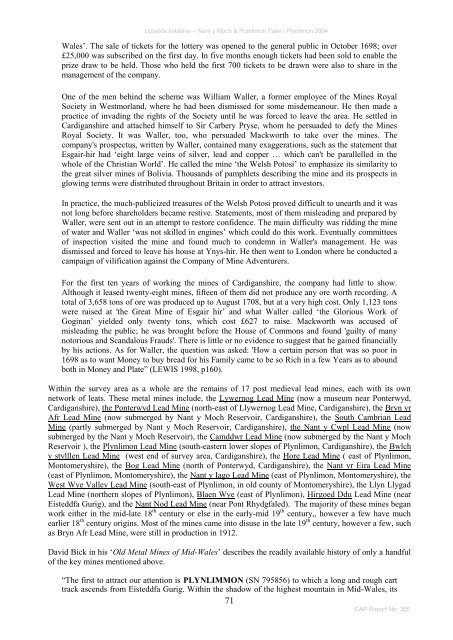

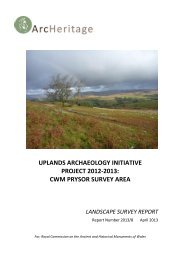
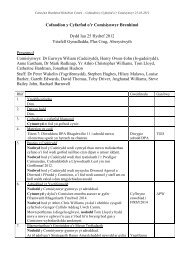


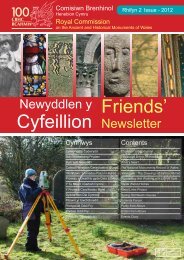
![The Source of the Usk Walk [2012 PDF]](https://img.yumpu.com/49285699/1/190x245/the-source-of-the-usk-walk-2012-pdf.jpg?quality=85)

